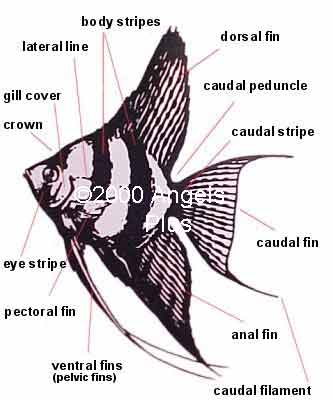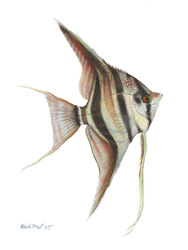Angelfish care, angels, pet fish, species, feeding, food, artemia, aquarium size, tank, filter, temperature, diseases, virus, flagellates, capillaria, parasites, medicines

Aquarium Size
The actual aquarium size is relatively unimportant. However, the number of angelfish per gallon is critical. This figure varies depending on several factors. Obviously, size has a lot to do with carrying capacity. Other variables that affect this include, pH, temperature, feeding practices, water changing volume, water changing frequency, strain of angelfish being kept and the overall quality of angelfish you desire to raise or maintain. Keep in mind, the number of angelfish per gallon a tank can handle, will vary immensely from one situation to another. The following would be a very general guideline.
| Nickel size bodies | 1 angelfish per gallon |
| Quarter size bodies | 1 angelfish per 2 gallons |
| Silver dollar size bodies | 1 angelfish per 3 gallons |
| Stock ready to be paired | 1 angelfish per 5 gallons |
| Full grown breeding pair | 20 gallon tall |
Aquarium Filter
Good biological filtration can be easily obtained a number of ways. Angelfish body shapes are not designed for efficient swimming, therefore gentle aquarium filtration is preferred. Lots of water movement will stress them somewhat and cause slower growth due to the increased energy expended to swim against a current. Angels Plus Sponge filters are ideal for fish hatchery situations, where expense is a concern. In show tanks, undergravel filters works well. In a densely populated tank, an undersized power filter or canister filter will make a good secondary filter. A very effective secondary filter that will not clog is a fluidized bed filter. We use these in all of our big tanks. In general, the limiting factor for angelfish carrying capacity is not filtration. It is dissolved organics and high bacterial loads that develop from keeping too many fish in a tank, overfeeding or changing too little water. Large, frequent water changes are the easiest way to lower these bacterial levels. Sophisticated systems will sometimes incorporate the use of ozone, foam fractionation and U.V. to accomplish the lowering of these organic and bacterial loads, but most of us will rely upon water changes to accomplish this important facet of angelfish care.
Aquarium Temperature
Angelfish have a tolerance to a wide range of aquarium temperatures, but immune system response is best at higher temperatures. Therefore, if your fish husbandry is less than ideal, you will have more problems at lower temperatures. 80° F is a good start for a hatchery situation. Mid to upper seventies is fine for show tanks.
As a cold blooded animal, angelfish will live longer at lower temps. Higher temperatures will promote faster growth, more frequent breeding, better immune system response and shorter life spans.
A good reliable aquarium heater is important for valuable angelfish.
Feeding Angelfish
Feeding is more of an art, than a science. No one can tell you exactly how much food to put in an aquarium. The ideal amount will change everyday as the angelfish grow, and will be different with varying temperature, pH, maintenance schedules and frequency of feedings.. Good observation is the key. Overfeeding angelfish is worse than underfeeding. Feed a variety of high quality foods and observe the aquarium and the angelfish closely when feeding. If you want to feed a superior fish food, try making your own paste fish food. We have a great fish paste food recipe.
Angelfish Fry - you will find it difficult to raise any number of high quality angelfish with anything other than live baby brine shrimp for the first 3 weeks of their life. We feed it exclusively for the first 5-6 weeks. Artemia is critical at this point. Check here for more details on hatching brine shrimp eggs. Introduction of a new fish food usually requires that it be introduced gradually. Angelfish should be voracious eaters when they are healthy and properly fed.
Culling Angelfish
Angelfish are an ornamental fish that have acquired many problems from improper breeding over the years. It is important to cull any juvenile angelfish that are not ideal. Degradation of your angelfish strains will happen very quickly without a vigorous program of eliminating flawed angelfish. It is equally important to not keep any spawns from imperfect adults. As exciting as raising young angelfish can be, it is a great disservice to the species and the hobby to perpetuate the genes of lower quality angelfish.
Angelfish Quarantine
Angelfish are affected by viruses, bacteria and parasites, that sometimes have little or no effect on fish other than a few South American cichlids. However, with angelfish some of these can cause death within a day or two. Others will simply cause nagging problems that never cease. The only good way to prevent the introduction of these problems is to properly quarantine every fish, plant or other aquatic animal that was obtained from any other source. A single micro-droplet of water from an aquarium containing a disease, can infect a healthy aquarium, so the quarantine tank should be in a separate room and preferably in a different building, with it's own net, siphon, water bucket, etc. When the quarantined fish look healthy after a few weeks, you will then have to test for hidden diseases that the quarantined fish may be resistant to. The best way to test for this is with a microscope. If you don't have access to one, then next best is to introduce one dispensable fish from a healthy tank into the quarantine tank and wait a couple weeks to see if the introduced fish gets sick. If it doesn't, then there is a fairly good chance that the quarantined fish are safe for introduction to your regular tanks.
Angelfish Disease
The following are the diseases that most commonly infect angelfish.
Angelfish Virus
A Potentially deadly disease. It is highly infectious. All exposed angelfish that are not immune will come down with symptoms within 2-3 days of exposure, usually quicker. If you suspect that a quarantined fish has this, you should destroy the fish. The risk is too great to keep such a fish around. There is no medication for this virus. The fish's immune system must be relied upon for the cure. Symptoms: Clamped fins, excess slime, listless with nose pointed up slightly, usually towards the back of the aquarium. It has an approximately 3 week infectious period. This disease is so undesirable, because if an angelfish survives the virus, it will likely become a carrier for up to six months. This can put an angelfish breeding operation out of business very quickly. These symptoms can also be caused by other infectious diseases which may be secondary or tertiary infections, that are unrelated to the virus. The object is to keep the angelfish comfortable while giving the immune system time to kick in. Remove any bright lights from the aquarium and treat with an antibiotic to prevent secondary infections.
Flagellates
Protozoans such as these cause persistent trouble in situations where angelfish are stressed. Hexamita is one that is very prevalent. It is thought to be present in all angelfish, at least in small numbers, and an outbreak is what you're trying to prevent. It appears to explode in numbers if the fish are too crowded, overfed or being overly stressed by some other situation in the aquarium. Stressing your angelfish, is what you need to avoid. Symptoms: If the angelfish is still eating, they will pass a white, chalky feces. Appetite will decrease. No external symptoms will appear on the angelfish. They are prone to secondary infections of bacteria and other parasites when in this weakened condition. To cure, relieve stress and then raise the tank temperature to 95° F for 7-10 days and medicate with metronidazole, or a medicated food that contains it.
Angelfish Parasites
The ones that cause the biggest problems with angelfish are a nematode known as Capillaria, and gill flukes. Many others can be present, but these two are the most common. The only way to positively identify a parasite, is to have a microscope and the know-how to examine gill samples, skin scraping, and fecal samples. This is beyond the average aquarist, so I generally recommend a heat treatment to help the angelfish fend off the parasitic infestation. Try 95° F. for 7-10 days if you suspect a parasite. If there is no response within that time, then it is likely something else, or a combination of pathogens.
Capillaria symptoms: The infected angelfish will have no appetite. They will commonly mouth their fish food and spit it out. The angelfish get progressively thinner until they die. Capillaria is a round worm that is hair-like, and up to an inch long. It is diagnosed by worm eggs in the feces. The worm egg is oval with a cork-like plug in each end. Severe capillaria infections are almost always accompanied with outbreaks of hexamita in the infected angelfish. This makes diagnosis and treatment even more difficult. For gill flukes, capillaria, or nematodes, treat with F.L.A.W., Disco-Med, or a medicated flake designed to de-worm.
Angelfish Medicine Cabinet
If you need to order medications after your angelfish have a problem, it may be too late. It's a good idea to have the basic medications on hand. Keep them stored cool, dry and dark and they will last long past the normal expiration dates. This is what we recommend that you have in your angelfish care arsenal.
- Disease Dip - Disinfectant for wounds, scrapes & abrasions.
- Broad spectrum Antibiotic - A couple to cover a wider range
- Internal parasite eliminator - F.L.A.W. will cover a wide range of internal parasites. Disco-Med is also very effective and more gentle on the fish.
- Metronidazole - To combat hexamita and spironucleus, two protozoans that are common problems.
- Ich Control, Formalite III - External parasite eliminator and fungus control.
- Medicated Foods designed to treat bacteria, worms and flagellates.
Although there are many other valuable medications, these will cover most of the more common angelfish problems. The medicated foods are especially important.
Aquarium Temperature for Fish Disease Treatment
As stated above, high temperatures are useful when treating parasite problems. Be careful, for there are many people who recommend heat for bacterial or viral infections. Their poor advice will most likely kill your angelfish. Bacteria and viruses thrive at higher temperatures and multiply at much faster rates. If you suspect an external bacterial problem, treatment is the application of the proper anti-biotic. This can only be determined by culturing the bacteria in an incubator, identifying it, and then testing to see what anti-biotic will kill it. If you can't do that, then try broad spectrum antibiotics such as Ampicillin, Trimethazole, Erthromycin or Triple Sulpha. If it's an internal bacteria, identification of the bacteria will require an angelfish to be sacrificed in order to get a fresh sample of the internal bacteria. Treatment for internal bacteria must be by intramuscular injection or by feeding a medicated fish food with the proper anti-biotic in it. In some cases a skin-adsorbing antibiotic such as Kanamycin will work, but it is the least likely to be effective. Of course, the angelfish must be eating well for a medicated fish food to work.
Angelfish Diseases References
A few of the better books for learning more about this topic are The Manual of Fish Health and Aquariology , both put out by Tetra and a TFH book, Discus Health.
Home | Dogs | Cats | Birds | Fish and aquariums | Ferret | Small pet | Free classified ads | Photos | Videos | Articles
Directory | Pet books | Dog books | Cat books | Bird books | Aquarium books | Ferret books | Small pet books



